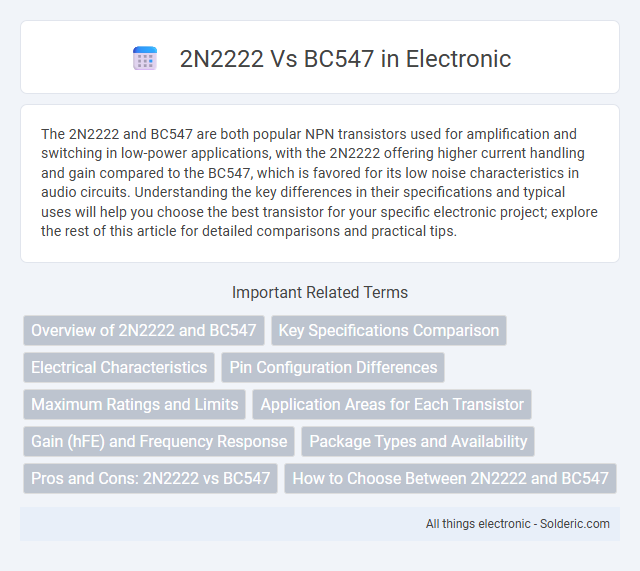The 2N2222 and BC547 are both popular NPN transistors used for amplification and switching in low-power applications, with the 2N2222 offering higher current handling and gain compared to the BC547, which is favored for its low noise characteristics in audio circuits. Understanding the key differences in their specifications and typical uses will help you choose the best transistor for your specific electronic project; explore the rest of this article for detailed comparisons and practical tips.
Comparison Table
| Parameter | 2N2222 | BC547 |
|---|---|---|
| Type | NPN Bipolar Junction Transistor | NPN Bipolar Junction Transistor |
| Maximum Collector Current (Ic) | 800 mA | 100 mA |
| Maximum Collector-Emitter Voltage (Vce) | 40 V | 45 V |
| Gain (hFE) | 100 to 300 | 110 to 800 |
| Transition Frequency (ft) | 300 MHz | 100 MHz |
| Package | TO-18 (Metal Can), TO-92 (Plastic) | TO-92 (Plastic) |
| Applications | Switching, Amplification, General Purpose | Low noise amplification, Signal processing |
Overview of 2N2222 and BC547
The 2N2222 and BC547 are popular NPN bipolar junction transistors widely used in amplification and switching applications. The 2N2222 offers higher current handling capacity, typically up to 800mA, while the BC547 is designed for low noise and signal amplification with a maximum current of around 100mA. Your choice between these transistors depends on whether you need higher current capability or better performance in low-level signal amplification.
Key Specifications Comparison
The 2N2222 and BC547 transistors differ notably in key specifications such as maximum collector current, voltage ratings, and gain bandwidth product. The 2N2222 typically supports a collector current up to 800mA and a collector-emitter voltage of 40V, making it suitable for higher power applications. In contrast, the BC547 handles a maximum collector current of 100mA and a collector-emitter voltage of 45V, offering higher gain but lower current capacity for precision low-power circuits.
Electrical Characteristics
The 2N2222 transistor features a higher maximum collector current of 800mA compared to the BC547's 100mA, making it suitable for higher power applications. Its maximum collector-emitter voltage is typically around 40V, while the BC547 generally handles up to 45V. You should choose the 2N2222 for circuits requiring greater current handling and switching speed, whereas the BC547 excels in low noise amplification with its lower current capacity.
Pin Configuration Differences
The 2N2222 transistor features a pin configuration with the emitter on the left, base in the middle, and collector on the right when viewed from the flat side with leads downward. In contrast, the BC547 transistor has the pin arrangement with the collector on the left, base in the middle, and emitter on the right under the same viewing conditions. Understanding these differences in pin layout is crucial for accurate circuit design and avoiding incorrect connections in electronic projects.
Maximum Ratings and Limits
The 2N2222 transistor features a maximum collector current of 800mA and a collector-emitter voltage rating of 40V, making it suitable for higher power applications. The BC547 transistor has a lower maximum collector current of 100mA and a collector-emitter voltage limit of 45V, ideal for low-power, low-noise switching. Choosing between these transistors depends on your circuit's current and voltage requirements to avoid exceeding these maximum ratings and damaging the components.
Application Areas for Each Transistor
The 2N2222 transistor excels in high-speed switching and amplification applications within automotive circuits, power regulators, and RF amplifiers due to its high current handling and gain bandwidth. The BC547 is preferred in low-noise audio amplification, signal processing, and small signal switching tasks, commonly found in consumer electronics and audio equipment. Your choice depends on whether your project requires robust current capacity and switching speed or low noise and precision in low-power environments.
Gain (hFE) and Frequency Response
The 2N2222 transistor typically has a gain (hFE) ranging from 100 to 300 and a higher frequency response up to 300 MHz, making it suitable for medium-power switching and amplifier circuits. In contrast, the BC547 features a gain range of 110 to 800 but operates effectively at lower frequencies, generally up to 100 MHz, which is ideal for low-noise, low-current applications. Your choice between 2N2222 and BC547 should consider the required gain and frequency response for your specific electronic circuit design.
Package Types and Availability
The 2N2222 transistor is commonly available in a TO-18 metal can and TO-92 plastic package, making it suitable for both prototyping and durable applications. The BC547 is predominantly found in the TO-92 package, which is compact and ideal for PCB mounting in low-power circuits. Your choice depends on the required package type and availability for specific project needs, with 2N2222 offering more options for rugged environments.
Pros and Cons: 2N2222 vs BC547
The 2N2222 transistor offers higher current handling capability up to 800mA and faster switching speeds, making it ideal for moderate power amplification and switching applications. The BC547, with a maximum collector current of around 100mA, excels in low-noise, low-power signal amplification, but it cannot handle high current loads like the 2N2222. While the 2N2222 is robust and suitable for driving loads such as relays and motors, the BC547 provides better performance in small-signal amplification tasks due to its lower noise and higher gain in low-power circuits.
How to Choose Between 2N2222 and BC547
When choosing between the 2N2222 and BC547 transistors, consider their maximum voltage and current ratings; the 2N2222 supports up to 40V and 800mA, making it ideal for higher power applications, while the BC547 handles up to 45V but only 100mA, suitable for low-power signal amplification. Your choice should also factor in the transistor's gain (hFE), with the BC547 typically offering a higher gain of 110-800 compared to the 2N2222's 100-300, influencing voltage amplification efficiency. Evaluate the application's power requirements and the physical package type, as 2N2222s usually come in TO-18 metal cans, offering better heat dissipation compared to the BC547's plastic TO-92 package.
2N2222 vs BC547 Infographic

 solderic.com
solderic.com